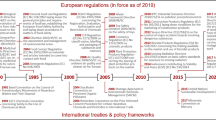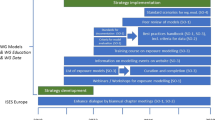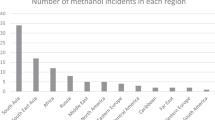Abstract
Exposure assessment during and after acute chemical incidents and disasters is essential for health studies that may follow. During chemical incidents, the focus usually lies on risk assessment and afterward attention shifts toward possible (long-term) health effects. This may lead to insufficient available data on exposure to study the association between exposure and health outcome, and collection of additional exposure data is often required. Literature on health studies conducted after several chemical incidents was reviewed to obtain better insight on the needs of health studies. Four different types of scenarios were distinguished based on when exposure data were collected and the exposure data used for health studies. These four scenarios gave insight on exposure data needed for conclusive health studies and when different methods of exposure data collection should be used. Literature indicated that adequate and rapid exposure assessment during chemical incidents is vital for health studies, because data that are not collected during or directly after an incident may be irretrievably lost. Poor exposure assessment is not always the only problem in health studies. Problems in health studies including poor exposure assessment may be prevented when the general design and needs of health studies are taken into account when designing contingency plans. Together with measures that will help facilitate funding, design, and coordination of health studies, disaster management programs should, among others, prepare for methods that lead to a swift identification of released substances, determination of concentrations and dispersion of released substances, designing basic questionnaire outlines, and rapid evaluation of the usefulness and necessity of employing biological sampling.
This is a preview of subscription content, access via your institution
Access options
Subscribe to this journal
Receive 6 print issues and online access
$259.00 per year
only $43.17 per issue
Buy this article
- Purchase on Springer Link
- Instant access to full article PDF
Prices may be subject to local taxes which are calculated during checkout
Similar content being viewed by others
References
Ackermann-Liebrich U.A., Braun C., and Rapp R.C. Epidemiologic analysis of an environmental disaster: the Schweizerhalle experience. Environ Res 1992: 58 (1): 1–14.
Alexeeff G.V., Shusterman D.J., Howd R.A., and Jackson R.J. Dose–response assessment of airborne methyl isothiocyanate (MITC) following a metam sodium spill. Risk Anal 1994: 14 (2): 191–198.
Aubin J., Potvin L., Beland F., and Pineault R. Utilization of a specialized clinic following an ecological accident. Med Care 1994: 32 (1): 1–14.
Bertazzi P.A. Long-term effects of chemical disasters. Lessons and results from Seveso. Sci Total Environ 1991: 106 (1–2): 5–20.
Bertazzi P.A., Bernucci I., Brambilla G., Consonni D., and Pesatori A.C. The Seveso studies on early and long-term effects of dioxin exposure: a review. Environ Health Perspect 1998: 106 (Suppl. 2): 625–633.
Bertazzi P.A., Consonni D., Bachetti S., Rubagotti M., Baccarelli A., and Zocchetti C., et al. Health effects of dioxin exposure: a 20-year mortality study. Am J Epidemiol 2001: 153 (11): 1031–1044.
Boin A., van Duin M., and Heyse L. Toxic fear: the management of uncertainty in the wake of the Amsterdam air crash. J Hazard Mater 2001: 88 (2–3): 213–234.
Bosch X. Exposure to oil spill has detrimental effect on clean-up workers' health. Lancet 2003: 361 (9352): 147.
Carrasco J.M., Lope V., Perez-Gomez B., Aragones N., Suarez B., and Lopez-Abente G., et al. Association between health information, use of protective devices and occurrence of acute health problems in the Prestige oil spill clean-up in Asturias and Cantabria (Spain): a cross-sectional study. BMC Public Health 2006: 6: 1.
Centers for Disease Control and Prevention (CDC). Preliminary report 2,3,7,8-tetrachlorodibenzo-p-dioxin exposure to humans-seveso, Italy. MMWR Morb Mortal Wkly Rep 1988: 37 (48): 733–736.
Centers for Disease Control and Prevention (CDC). Physical health status of World Trade Center rescue and recovery workers and volunteers — New York City, July 2002–August 2004. MMWR Morb Mortal Wkly Rep 2004: 53 (35): 807–812.
Cone J.E., Wugofski L., Balmes J.R., Das R., Bowler R., and Alexeeff G., et al. Persistent respiratory health effects after a metam sodium pesticide spill. Chest 1994: 106 (2): 500–508.
Crabb C. Revisiting the Bhopal tragedy. Science 2004: 306 (5702): 1670–1671.
Cullinan P. Epidemiological assessment of health effects from chemical incidents. Occup Environ Med 2002: 59 (8): 568–572; quiz 572,516.
Das D., Weiss D., Mostashari F., Treadwell T., McQuiston J., and Hutwagner L., et al. Enhanced drop-in syndromic surveillance in New York City following September 11, 2001. J Urban Health 2003: 80 (2 Suppl. 1): i76–i88.
Dayal H.H., Baranowski T., Li Y.H., and Morris R. Hazardous chemicals: psychological dimensions of the health sequelae of a community exposure in Texas. J Epidemiol Community Health 1994a: 48 (6): 560–568.
Dayal H.H., Brodwick M., Morris R., Baranowski T., Trieff N., and Harrison J.A., et al. A community-based epidemiologic study of health sequelae of exposure to hydrofluoric acid. Ann Epidemiol 1992: 2 (3): 213–230.
Dayal H.H., Li Y.H., Dayal V., Mittal C.K., and Snodgrass W. Use of medication data to validate an association in community-based symptom prevalence studies. Arch Environ Health 1994b: 49 (2): 93–97.
Dhara V.R. What ails the Bhopal disaster investigations? (And is there a cure?). Int J Occup Environ Health 2002: 8 (4): 371–379.
Dhara V.R., and Dhara R. The Union Carbide disaster in Bhopal: a review of health effects. Arch Environ Health 2002: 57 (5): 391–404.
Dhara V.R., Dhara R., Acquilla S.D., and Cullinan P. Personal exposure and long-term health effects in survivors of the union carbide disaster at Bhopal. Environ Health Perspect 2002: 110 (5): 487–500.
di Domenico A., Silano V., Viviano G., and Zapponi G. Accidental release of 2,3,7,8-tetrachlorodibenzo-p-dioxin (TCDD) at Seveso, Italy. II. TCDD distribution in the soil surface layer. Ecotoxicol Environ Saf 1980: 4 (3): 298–320.
Donker G.A., Yzermans C.J., Spreeuwenberg P., and van der Zee J. Symptom attribution after a plane crash: comparison between self-reported symptoms and GP records. Br J Gen Pract 2002: 52 (484): 917–922.
Eskenazi B., Mocarelli P., Warner M., Chee W.Y., Gerthoux P.M., and Samuels S., et al. Maternal serum dioxin levels and birth outcomes in women of Seveso, Italy. Environ Health Perspect 2003: 111 (7): 947–953.
Eskenazi B., Mocarelli P., Warner M., Needham L., Patterson Jr. D.G., and Samuels S., et al. Relationship of serum TCDD concentrations and age at exposure of female residents of Seveso, Italy. Environ Health Perspect 2004: 112 (1): 22–27.
Eskenazi B., Mocarelli P., Warner M., Samuels S., Needham L., and Patterson D., et al. Seveso Women's Health Study: does zone of residence predict individual TCDD exposure? Chemosphere 2001: 43 (4–7): 937–942.
Eskenazi B., Mocarelli P., Warner M., Samuels S., Vercellini P., and Olive D., et al. Seveso Women's Health Study: a study of the effects of 2,3,7,8-tetrachlorodibenzo-p-dioxin on reproductive health. Chemosphere 2000: 40 (9–11): 1247–1253.
Eskenazi B., Mocarelli P., Warner M., Samuels S., Vercellini P., and Olive D., et al. Serum dioxin concentrations and endometriosis: a cohort study in Seveso, Italy. Environ Health Perspect 2002: 110 (7): 629–634.
Fireman E.M., Lerman Y., Ganor E., Greif J., Fireman-Shoresh S., and Lioy P.J., et al. Induced sputum assessment in New York City firefighters exposed to World Trade Center dust. Environ Health Perspect 2004: 112 (15): 1564–1569.
Herbert R., Moline J., Skloot G., Metzger K., Baron S., and Luft B., et al. The World Trade Center disaster and the health of workers: five-year assessment of a unique medical screening program. Environ Health Perspect 2006: 114 (12): 1853–1858.
Heudorf U., and Peters M. [Human biomonitoring after a severe chemical accident — results of a study after the Hoechst AG chemical spill 22 February 1993]. Gesundheitswesen 1994: 56 (10): 558–562.
Johnson S.B., Langlieb A.M., Teret S.P., Gross R., Schwab M., and Massa J., et al. Rethinking first response: effects of the clean up and recovery effort on workers at the world trade center disaster site. J Occup Environ Med 2005: 47 (4): 386–391.
Koehler G.A., and Van Ness C. The emergency medical response to the Cantara hazardous materials incident. Prehosp Disaster Med 1993: 8 (4): 359–365.
Koo D., Goldman L., and Baron R. Irritant dermatitis among workers cleaning up a pesticide spill: California 1991. Am J Ind Med 1995: 27 (4): 545–553.
Landi M.T., Consonni D., Patterson Jr. D.G., Needham L.L., Lucier G., and Brambilla P., et al. 2,3,7,8-Tetrachlorodibenzo-p-dioxin plasma levels in Seveso 20 years after the accident. Environ Health Perspect 1998: 106 (5): 273–277.
Lang T., Schwoebel V., Diene E., Bauvin E., Garrigue E., and Lapierre-Duval K., et al. Assessing post-disaster consequences for health at the population level: experience from the AZF factory explosion in Toulouse. J Epidemiol Community Health 2007: 61 (2): 103–107.
Lioy P.J., and Georgopoulos P. The anatomy of the exposures that occurred around the World Trade Center site: 9/11 and beyond. Ann NY Acad Sci 2006: 1076: 54–79.
Lioy P.J., Pellizzari E., and Prezant D. The World Trade Center aftermath and its effects on health: understanding and learning through human-exposure science. Environ Sci Technol 2006: 40 (22): 6876–6885.
Lo S.H., Chan C.C., Chen W.C., and Wang J.D. Grand rounds: outbreak of hematologic abnormalities in a community of people exposed to leakage of fire extinguisher gas. Environ Health Perspect 2006: 114 (11): 1713–1717.
Mennen M.G., Kliest J.J.G., and van Bruggen M. Vuurwerkramp Enschede: Metingen van concentraties, verspreiding en depositie van schadelijke stoffen: [Fireworks Tragedy in Enschede, The Netherlands: Measurements for Concentrations, Dispersion and Deposition of Harmful Substances: Report of the Environment Study]. RIVM, Bilthoven, 2001.
Mocarelli P., Needham L.L., Marocchi A., Patterson Jr. D.G., Brambilla P., and Gerthoux P.M., et al. Serum concentrations of 2,3,7,8-tetrachlorodibenzo-p-dioxin and test results from selected residents of Seveso, Italy. J Toxicol Environ Health 1991: 32 (4): 357–366.
Moline J., Herbert R., and Nguyen N. Health consequences of the September 11 World Trade Center attacks: a review. Cancer Invest 2006: 24 (3): 294–301.
Patterson Jr. D.G., Hampton L., Lapeza Jr. C.R., Belser W.T., Green V., and Alexander L., et al. High-resolution gas chromatographic/high-resolution mass spectrometric analysis of human serum on a whole-weight and lipid basis for 2,3,7,8-tetrachlorodibenzo-p-dioxin. Anal Chem 1987: 59 (15): 2000–2005.
Perez-Cadahia B., Lafuente A., Cabaleiro T., Pasaro E., Mendez J., and Laffon B. Initial study on the effects of Prestige oil on human health. Environ Int 2007: 33 (2): 176–185.
RIVM Project Team Health Research Firework Disaster Enschede. Vuurwerkramp Enschede: Stoffen in bloed en urine; rapportage van het gezondheidsonderzoek [Firework Disaster Enschede: Measurements of Elements in Blood and Urine; Health Impact Assessment]. RIVM, Bilthoven, 2001.
Roorda J., van Stiphout W.A., and Huijsman-Rubingh R.R. Post-disaster health effects: strategies for investigation and data collection. Experiences from the Enschede firework disaster. J Epidemiol Community Health 2004: 58 (12): 982–987.
Salzman S.H., Moosavy F.M., Miskoff J.A., Friedmann P., Fried G., and Rosen M.J. Early respiratory abnormalities in emergency services police officers at the World Trade Center site. J Occup Environ Med 2004: 46 (2): 113–122.
Sharma D.C. Bhopal's health disaster continues to unfold. Lancet 2002: 360 (9336): 859.
Slottje P., Bijlsma J.A., Smidt N., Twisk J.W., Huizink A.C., and Lems W.F., et al. Epidemiologic study of the autoimmune health effects of a cargo aircraft disaster. Arch Intern Med 2005a: 165 (19): 2278–2285.
Slottje P., Huizink A.C., Twisk J.W., Witteveen A.B., van der Ploeg H.M., and Bramsen I., et al. Epidemiological study air disaster in Amsterdam (ESADA): study design. BMC Public Health 2005b: 5 (1): 54.
Suarez B., Lope V., Perez-Gomez B., Aragones N., Rodriguez-Artalejo F., and Marques F., et al. Acute health problems among subjects involved in the cleanup operation following the Prestige oil spill in Asturias and Cantabria (Spain). Environ Res 2005: 99 (3): 413–424.
Traupe H., Menge G., Kandt I., and Karmaus W. Higher frequency of atopic dermatitis and decrease in viral warts among children exposed to chemicals liberated in a chemical accident in Frankfurt, Germany. Dermatology 1997: 195 (2): 112–118.
Uijt de Haag P.A., Smetsers R.C., Witlox H.W., Krus H.W., and Eisenga A.H. Evaluating the risk from depleted uranium after the Boeing 747-258F crash in Amsterdam, 1992. J Hazard Mater 2000: 76 (1): 39–58.
Upshur R., James M.L., Richardson E., Brunton G., Hunter W., and Chambers L. Short-term adverse health effects in a community exposed to a large polyvinylchloride plastics fire. Arch Environ Health 2001: 56 (3): 264–270.
Warner M., Eskenazi B., Mocarelli P., Gerthoux P.M., Samuels S., and Needham L., et al. Serum dioxin concentrations and breast cancer risk in the Seveso Women's Health Study. Environ Health Perspect 2002: 110 (7): 625–628.
Warner M., Samuels S., Mocarelli P., Gerthoux P.M., Needham L., and Patterson Jr. D.G., et al. Serum dioxin concentrations and age at menarche. Environ Health Perspect 2004: 112 (13): 1289–1292.
WHO Regional Office for Europe. Assessing the health consequences of major chemical incidents — epidemiological approaches. WHO Reg Publ Eur Ser 1997: 79 (iii–xiv): 1–90.
Wolff M.S., Teitelbaum S.L., Lioy P.J., Santella R.M., Wang R.Y., and Jones R.L., et al. Exposures among pregnant women near the World Trade Center site on 11 September 2001. Environ Health Perspect 2005: 113 (6): 739–748.
Yzermans C.J., Donker G.A., Kerssens J.J., Dirkzwager A.J., Soeteman R.J., and ten Veen P.M. Health problems of victims before and after disaster: A longitudinal study in general practice. Int J Epidemiol 2005: 34 (4): 820–826.
Zock J.P., Rodriguez-Trigo G., Pozo-Rodriguez F., Barbera J.A., Bouso L., and Torralba Y., et al. Prolonged respiratory symptoms in clean-up workers of the Prestige oil spill. Am J Respir Crit Care Med 2007: 176 (6): 610–616.
Acknowledgements
We thank Professor Paul Lioy for his valuable comments on the draft manuscript. This study is funded by the National Institute for Public Health and the Environment, the Netherlands.
Author information
Authors and Affiliations
Corresponding author
Rights and permissions
About this article
Cite this article
Bongers, S., Janssen, N., Reiss, B. et al. Challenges of exposure assessment for health studies in the aftermath of chemical incidents and disasters. J Expo Sci Environ Epidemiol 18, 341–359 (2008). https://doi.org/10.1038/jes.2008.23
Received:
Accepted:
Published:
Issue Date:
DOI: https://doi.org/10.1038/jes.2008.23
Keywords
This article is cited by
-
Airborne transmission of biological agents within the indoor built environment: a multidisciplinary review
Air Quality, Atmosphere & Health (2023)
-
Exposure index of methyl isocyanate (MIC) gas disaster and a comprehensive spectrum of cytogenetic analysis after 30 years
Environmental Science and Pollution Research (2019)
-
Source reconstruction of airborne toxics based on acute health effects information
Scientific Reports (2018)
-
Spectrum of health condition in methyl isocyanate (MIC)-exposed survivors measured after 30 years of disaster
Environmental Science and Pollution Research (2018)
-
Arsenic contamination assessment 40 years after an industrial disaster: measurements and deposition modeling
Air Quality, Atmosphere & Health (2018)



